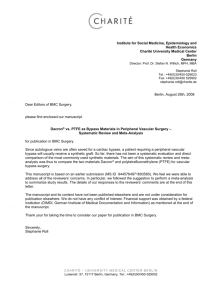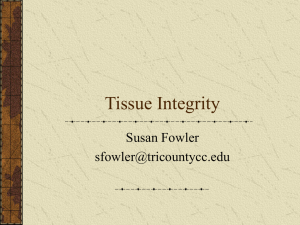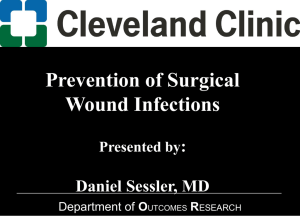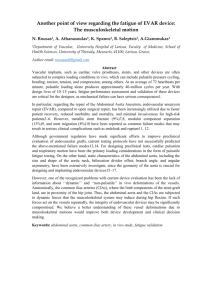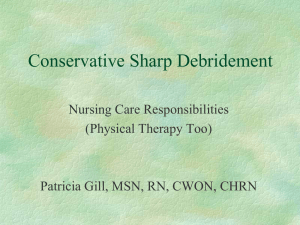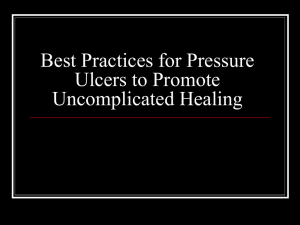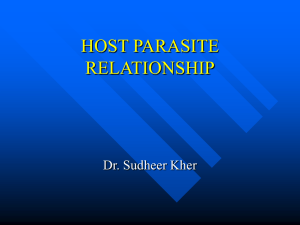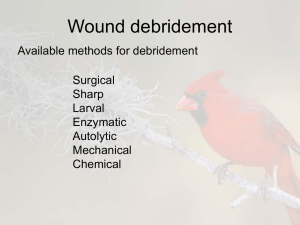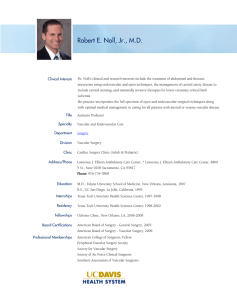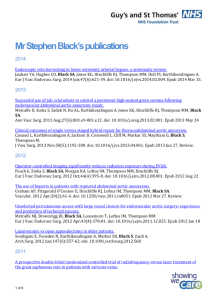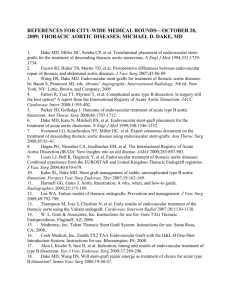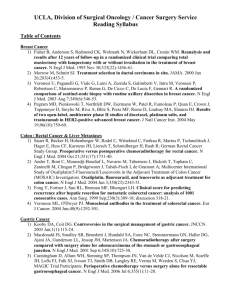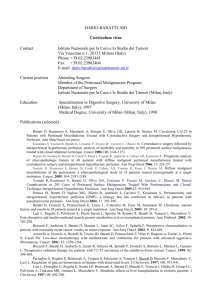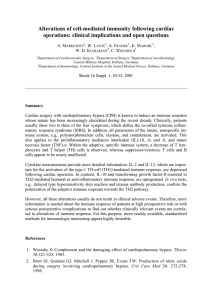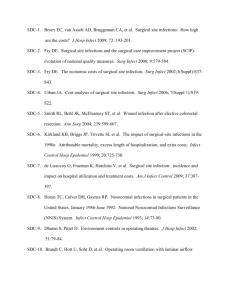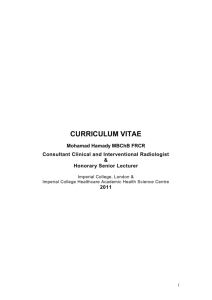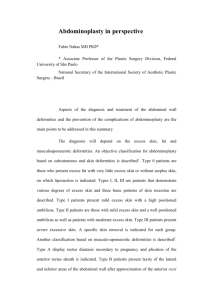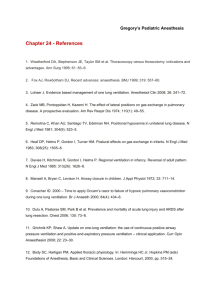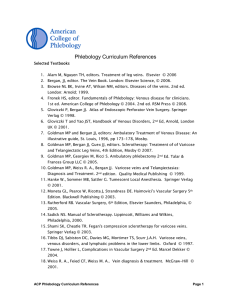Slide 1
advertisement
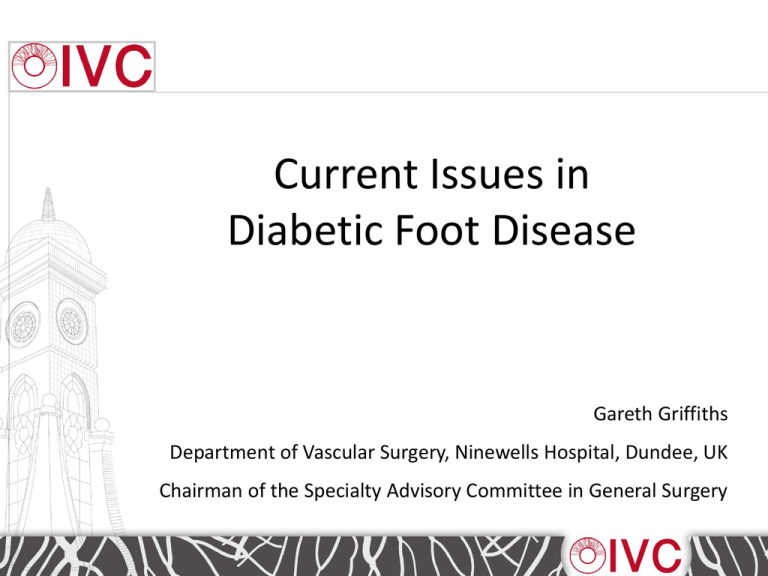
Current Issues in Diabetic Foot Disease Gareth Griffiths Department of Vascular Surgery, Ninewells Hospital, Dundee, UK Chairman of the Specialty Advisory Committee in General Surgery Multi-factorial Pathogenesis • Connective tissue changes • Peripheral neuropathy – Somatic sensory – Somatic motor – Autonomic • • • • Pressure point development Immunological dysfunction Infection Superadded ischaemia Eurodiale Study • Multicentre European cohort study • 1229 patients studied in 2003/2004 • Arterial disease • Infection • Non-plantar 49% 58% 52% PAD - PAD + Infection - 24% 18% Infection + 27% 31% Older Nonplantar Comorbidity Diabetologia 2008;50:18-25 Treatment Plan • Connective tissue changes • Peripheral neuropathy • Pressure point development Identify Protect Prevent • Immunological dysfunction • Infection Antibiotics Debridement Wound care • Superadded ischaemia Endovascular Bypass Infection Gram +ve 32% Gram -ve Anaerobes 51% 15% Polymicrobial 75% Enterobacteriaceae 28% Anaerobic gram –ve 11% Pseudomonas 17% MRSA 8% Staph Aureus 12% Enterococcus 7% Gram +ve: vancomycin Gram -ve: piperacillin-tazobactam / amikacin Al Benwan et al J Inf Pub Health 2012;5:1-8 ESBL: 10% of E coli and Proteus Tascini et al Diab Res Clin Prac 2011;94:133-9 Infection • Local debridement – – – – – Sharp Autolytic Fly larvae Versajet None better than sharp • Surgical debridement – As radical as needs be – Only get one chance in severe infection – Beware of leaving a metatarsal head Surgical Debridement Revascularisation Correct the correctable Endovascular techniques Surgical bypass Patient fitness Vein quality Arterial target quality Life expectancy If good - Bypass If mediocre - Bypass / endovascular If poor - Endovascular BASIL Trial, Lancet 2005;366:1925-34 • Bypass better for extensive tissue loss Neville et al Sem Vasc Surg 2012;25:102-7 • Aim for in line flow into the foot Angiosomes • Concept introduced in 1987 Taylor et al Br J Plast Surg 1987;40:113 • 3D zones – Supplied by specific source arteries – Drained by specific veins • Patent bypass but failed healing in 10-18% Simons et al J Vasc Surg 2010;51:1419-24 Angiosomes anterior tibial posterior tibial peroneal 6. direct vs indirect Alexandrescu et al J Endovasc Ther 2008;15:580-593 Angiosomes • Factors influencing choice of target vessel – Length of available autogenous vein – Quality of tibial arteries and skin – ?angiosome affected • ? direct revacularisation better than indirect Neville et al Ann Vasc Surg 2009;23:367-373 Varela et al Vasc Endovasc Surg 2010;44:654-60 Iida et al J Vasc Surg 2012;55:363-70 • Indirect revascularisation better than none Wound Management • Simple dressings – No evidence that any are superior • Negative pressure wound dressings – Reduces oedema, ?stimulates angiogenesis – Accelerates healing of ulcers and debrided wounds Blume et al Diab Care 2008;31:631-6 Armstrong et al Lancet 2005;366:1704-10 Apelqvist Am J Surg 2008;195:782-8 Adjunctive Wound Management • Cell derived growth factor treatment • Hyperbaric oxygen • Extracorporeal shock wave • None have been shown conclusively to be of value Adjunctive Wound Management Cell derived growth factor treatment • Fibroblast derived dermal substitute (Dermagraft) – Cultured human fibroblasts, bioabsorbable scaffold Marston et al (RCT) Diab Care 2003;26:1701-5 • Allogenic cultured skin (Apligraf) – Cultured human keratinocytes and fibroblasts with bovine collagen Edmonds et al (RCT) Int J Lower Ext Wounds 2009;8:11-18 Veves et al Diab Care 2001;24:290-5 Adjunctive Wound Management Hyperbaric Oxygen • Mechanism of action – Stimulates angiogenesis – Enhances fibroblast and leukocyte function – Normalises cutaneous microvascular reflexes • Small, underpowered studies – No conclusive evidence for improved healing Kranke et al Cochrane Database Syst Rev 2004(2):CD004123 • More recent randomised controlled trial – Suggested greater healing rate at 1 year Londahl Diab Care 2010;33:998-1003 • ?More effective if TCpO2 is >25mmHg • Expensive and difficult for daily treatment Adjunctive Wound Managment Extracorporeal Shock Wave Therapy • Mechanism of action uncertain – ?increased angiogenesis via growth factor stimulation – ?neolymphogenesis – ?improved wound perfusion, increased cell proliferation, reduced apoptosis •?Improved healing over hyperbaric oxygen Wang et al Diab Res Clin Prac 2011;92:187-93 First Principles • Identify • Protect • Prevent • If ulcers develop, – Treat aggressively • • • • Eradicate infection Revascularise Re-epithelialise Pressure relief
